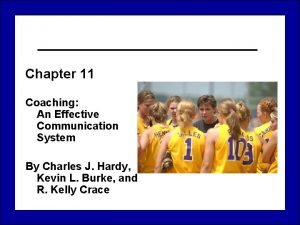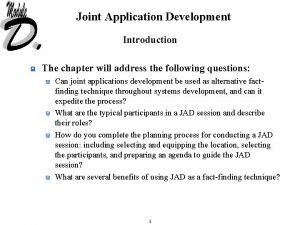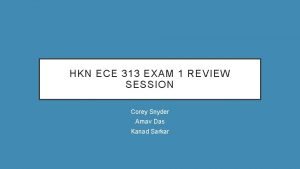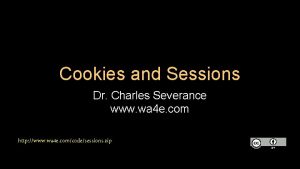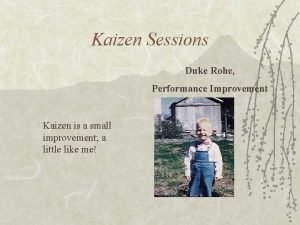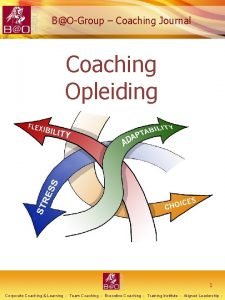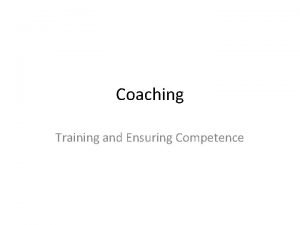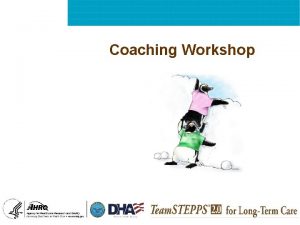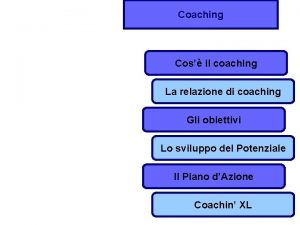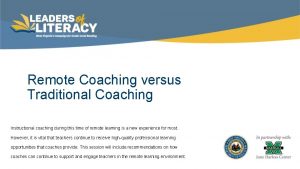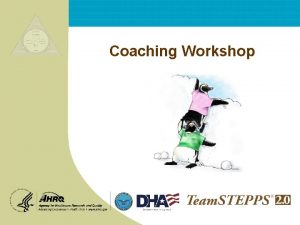Effective Coaching Sessions Getting the most value from














- Slides: 14

Effective Coaching Sessions Getting the most value from the program Proprietary and Confidential

Introduction Once you’ve identified the affected driver and investigated to determine whether they have previously received complaints, tickets or been involved in collisions, you’re ready to start the coaching process. ► Re-read the Motorist Observation Report. If any details seem odd or you have any questions about the details, contact Safety. First prior to discussing with your driver. Set the stage for a calm, private discussion ► Find a quiet, neutral place for the coaching session ► Provide a tactful notice to driver that you want to discuss a report, don’t make a spectacle out of the fact that they’ve received a report 10/30/2020 Proprietary and Confidential 2

The Coaching Session Let your driver know your goals/expectations for the meeting: ► “My goal today is to review the Motorist Observation Report with you, discuss what you remember of the situation and discuss what could have been done to be safer tomorrow. ” ► “I’m not interested in arguing about who may have been “right or wrong”, just how we can avoid collisions” ► Remember, drivers will set their tone/attitude based on your own -- be calm and direct. ► Let your driver know that every coaching session includes “no-fault” safety training (i. e. it doesn’t matter whether the driver did anything “wrong” to cause the incident – all drivers will participate in safety training by reading attached safety fact sheets or similar materials) 10/30/2020 Proprietary and Confidential 3

The Coaching Session Describe the report details and invite the driver to recall their actions Ask questions for clarification, but try not to interrupt too frequently. Listen actively - make notes and reconfirm details to reinforce your understanding. Drawing a diagram may help to explain the situation. Empathize with the driver. Let them know that you can identify how you would feel in their place. ► Ask the driver if they would make different choices in a similar situation tomorrow. ► ► Make sure that the driver reads the safety bulletin 10/30/2020 Proprietary and Confidential 4

The Coaching Session As you wrap up the interview process… ► Tell the driver how you feel about the observation report. ► Explain how, as a professional driver, their job is in the “public eye” --customers, shippers, and other professionals are watching. ► Take your time, choose your words carefully. Give the driver the benefit of any doubts, and convey your concern for the driver: ► ► They are important to the company The report serves as a reminder that driving can become “automatic” You don’t want to see them in a crash Offer more extensive training as a positive, not “punishment” Sign and date the MOR, and let the employee know that their signature doesn’t admit fault or blame – merely an acknowledgement that they’ve participated in the coaching session. 10/30/2020 Proprietary and Confidential 5

The Coaching Session In preparation for report closeout: ► Sign and date the MOR, and ► Let the employee know that their signature doesn’t admit fault or blame – merely an acknowledgement that they’ve participated in the coaching session. ► Return the report to Safety. First for closeout and save a copy in your files. 10/30/2020 Proprietary and Confidential 6

Avoiding common “traps” during coaching sessions While it is important to listen and understand your driver’s recollection of the incident, try to avoid common “traps” that other safety directors have encountered during coaching sessions. Drivers may start arguments about details such as location descriptions that are reasonably close but slightly inaccurate. ► For example, the MOR states that the incident occurred at or near a different cross street that was within several blocks of where your driver remembers the incident happening. ► Sometimes the motorist selects a location reference based on where they are when making the report, not where the incident originally took place. This introduces an error into the reporting, but doesn’t invalidate the actions they witnessed (the actions that could lead to a collision) ► Acknowledging that slight location description errors may happen, and redirecting the conversation to the described actions may help re-focus the coaching session. ● (Thanks to Mark, Safety Director at a delivery company) 10/30/2020 Proprietary and Confidential 7

Avoiding common “traps” during coaching sessions Drivers may attempt to “negotiate” with you ► If they can cite enough trivial “errors” with the report (i. e. the report says “raining”, but the rain had stopped prior to the incident), then they believe you’ll have to ignore the report entirely. ► The safety hotline reporting process depends on the recollection of the motorist, often impeded by calling in on a cell phone (and rushing through the details). It’s possible that minor details such as weather or road conditions are open to “interpretation” by your driver, but these details do not invalidate the point of the report – based on the local conditions and the positioning of the various vehicles, there may be a “train-able moment” that will increase the personal safety of your driver. ► Keep re-directing your driver to the goals of the coaching session (improve safety performance, protect your driver from potential injury) and avoid “negotiating” away the validity of the report as a mechanism to trigger a training session. ● (Thanks to Jeff, Driver Supervisor at a utility services company) 10/30/2020 Proprietary and Confidential 8

Avoiding common “traps” during coaching sessions Drivers may point out that the program is “unfairly” biased since the majority of reports are about “negative behaviors” ► It is true that 90% of all reports do highlight risk taking behaviors, and that most “behavior safety culture” programs seek to provide “positive reinforcement” of appropriate behaviors. ► If the goal of the program was to criticize and punish, then it would be at odds with reinforcing a safety culture; however, the goal of the program is to discuss safe driving practices and encourage consistent proper handling of vehicles regardless of conditions encountered (such as other drivers who don’t drive properly) ● (Thanks to Kate, OS+H Director at a Service company) 10/30/2020 Proprietary and Confidential 9

Avoiding common “traps” during coaching sessions Drivers may point out that motorists are not “trained observers” (i. e. “Highway Watch” certification). ► Highway Watch is a program that helped professional truck drivers notice and report situations that may require professional intervention: accidents, stranded motorists, and other types of suspicious activity (i. e. potential terrorist activity). ● Highway Watch was a great program (it has been suspended), but it’s goal was to teach drivers to spot the “otherwise unnoticed events that may be important”. ● Our program relies on drivers to report incidents that directly involved them or took place in an obvious manner. ► Most motorists have no problem describing what they saw. They may get a cross street name incorrect, but they can articulate that they were endangered or saw something that warranted follow up. ● (Thanks to Victor, Operations Manager at a trucking company) 10/30/2020 Proprietary and Confidential 10

Avoiding common “traps” during coaching sessions Drivers may point out that MORs are “hearsay” reports and are not as valid as “moving violations” issued by Police Officers. ► While most companies do evaluate each drivers’ history of moving violations (and police reported crashes) as part of their driver qualification process, a coaching session has benefits over getting a ticket: ● The police don’t offer training to help avoid future incidents ● Tickets increase personal insurance rates ● Fines are usually paid out of pocket by the driver ● At least the driver can offer a description of the incident and focus on safety awareness during a coaching session ► Violations are an expensive way to identify drivers who need help or training to prevent possible injuries or collisions. ► Violations are given out because a law was broken, MORs are generated, in part, to prevent violations (if the training is put into practice by the affected driver) ● (Thanks to Jerry, Driver Supervisor at an electrical contractor company) 10/30/2020 Proprietary and Confidential 11

Connection Between Multiple Reports & Crash Rates? Based on studies of Motor Vehicle Report (MVR) data, most safety experts agree that as a driver accrues more violations and/or crashes, their likelihood of continued violations and crashes increases. ► A recent study of over 540, 000 commercial drivers’ records, conducted by the American Transportation Research Institute (ATRI – www. atri-online. org) found that the occurrence of a single moving violation dramatically increases the likelihood of becoming involved in a crash (in the time period following the receipt of the ticket). ► From their study: ● “The four convictions with the highest likelihood of a future crash are: § improper or erratic lane change; § failure to yield right of way; § improper turn; and § failure to maintain proper lane. ● When a driver receives a conviction for one of these behaviors, the likelihood of a future crash increases between 91 and 100 percent. ” 10/30/2020 Proprietary and Confidential 12

Connection Between Multiple Reports & Crash Rates? Our Motorist Observation Reports, while not the same as a ticket received from a patrol officer, do highlight the same types of behaviors. It is reasonable to assume that there may be a correlation between the receipt of multiple MORs on a specific behavior such as failure to maintain proper lane spacing, and a subsequent crash – if there were no intervention by management to change the driver’s habits on the road. 10/30/2020 Proprietary and Confidential 13

Where Can I Get More Help? Safety. First employs a team of dedicated professionals to help you make the program a success. ► Every client has a dedicated point of contact at Safety. First ● Our operations center manager and her supervisors are available during normal business hours (Eastern Time Zone) ● Special Account Executives and Account Managers are on staff to assist our multiple location accounts. ► You can contact us by calling our toll free number – 1 -888 -603 -6987 ► We also have many resources available at our web site – ● Client Reference and Support Library ● Published Safety Articles ● Technical Presentations ● Ten-Minute Training Topic Archive ● Customer Satisfaction Surveys ● Ad-Hoc Report Creator ● Specialty Reports and Download Center 10/30/2020 Proprietary and Confidential www. safetyfirst. com 14
 The secret of getting ahead is getting started
The secret of getting ahead is getting started Penciptaan nilai adalah
Penciptaan nilai adalah Coaching in effective communication
Coaching in effective communication 3.05 getting the most for your money
3.05 getting the most for your money Joint application development
Joint application development Ece 313
Ece 313 Employee listening sessions
Employee listening sessions Academic success center
Academic success center Asn scientific sessions
Asn scientific sessions Dr. charles severance
Dr. charles severance Webex teams breakout rooms
Webex teams breakout rooms Rolling stones timeline
Rolling stones timeline V$system_wait_class
V$system_wait_class Kaizen sessions
Kaizen sessions Data analysis, interpretation and presentation
Data analysis, interpretation and presentation


